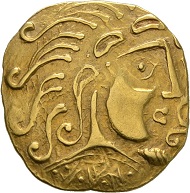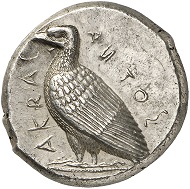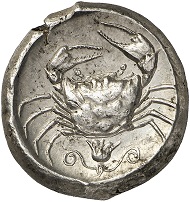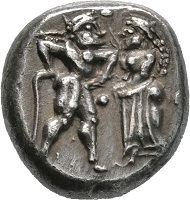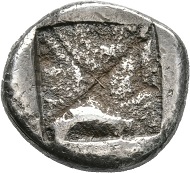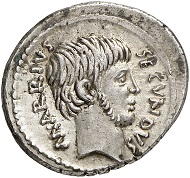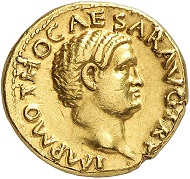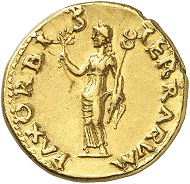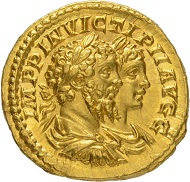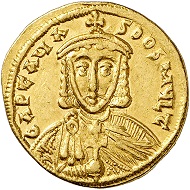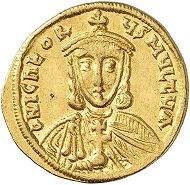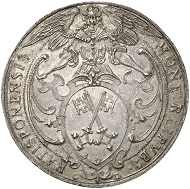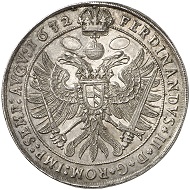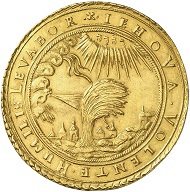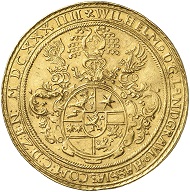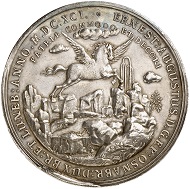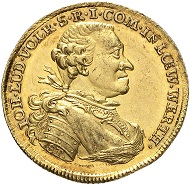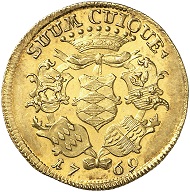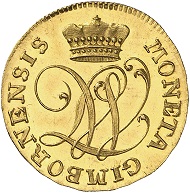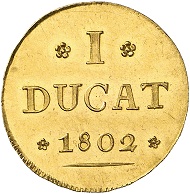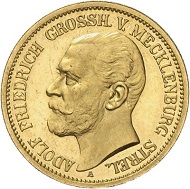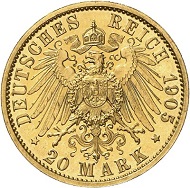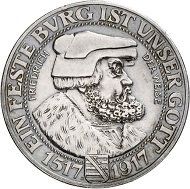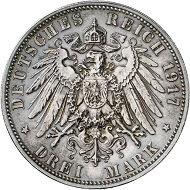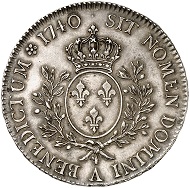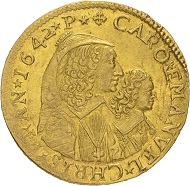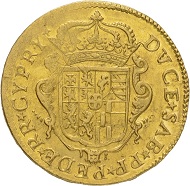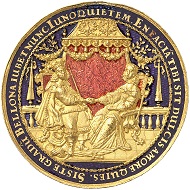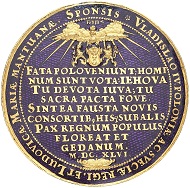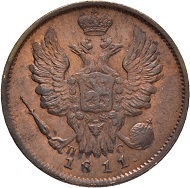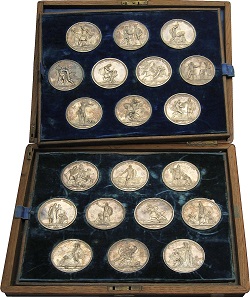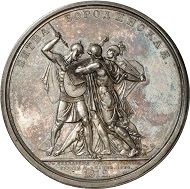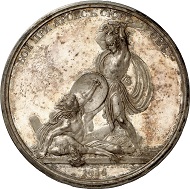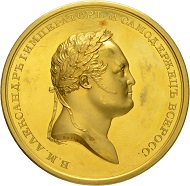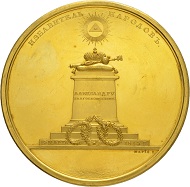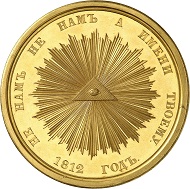20-06-2016 – 22-06-2016
Summer Auctions 277-279
Künker summer-auction: Russian Rarities
Almost 3,200 lots will be auctioned off at the Künker summer-auction taking place at the Osnabrück Steigenberger Hotel Remarque from June 21st to the 23rd, 2016. Overall, the lots are estimated slightly over 7 million euros. An impressive sum for which mainly the extraordinary Russian rarities are responsible. But, of course, the auction offers lots in every price range, from antiquity to the present, from Germany, Europe and the world.
Antiquity
The auction will kick off with about 200 lots from antiquity. And the offerings are impressive.
Lot 3: PARISII. Gold stater, around 60 BC. Very rare. Good very fine. Estimate: 20,000 euros.
Celtic coinage features a stater of Parisii displaying a quite modern looking abstract design which was imitating King Philips Macedonian gold staters (estimate: 20,000 euros).
Among the 70 Greek coins are also many rarities. They are not only characterized by their artistic quality, but also their perfect condition.
Lot 17: AKRAGAS (Sicily). Tetradrachm, 471-430. Very rare. Extremely fine. Estimate: 20,000 euros.
We just can name a few: a tetradrachm from Akragas (estimate: 20,000 euros), …
Lot 36: BERGE (Thrace). Stater, around 500. Ex Pozzi Coll. 688. Very rare. Extremely fine. Estimate: 40,000 euros.
… a stater from Berge (today’s Neos Skopos), a coin which, at a time, was thought to have been minted by the city of Lete (estimate: 40,000 euros), and an electron stater from Cyzicus its obverse displaying the head of Aphrodite (estimate: 75,000 euros).
Lot 92: ROMAN REPUBLIC. M. Arrius Secundus. Denarius, 43 BC. Cr. 513/2. Very rare. Extremely fine. Estimate: 10,000 euros.
After a small session with Roman Republican coins – including an extremely fine specimen of the most rare denarius of M. Arrius Secundus featuring a portrait of Octavian on the obverse and his military honors on the reverse (estimate: 10,000 euros) – coins of the Roman Empire follow. As in the past, this session offers many aurei in outstanding grades.
Lot 118: OTHO, 69. Aureus, Rome. Very rare. Extremely fine. Estimate: 75,000 euros.
Great examples are an extremely fine aureus of Otho (estimate: 75,000 euros), an extremely fine aureus from Domitian as Caesar, displaying the she-wolf nursing Romulus and Remus on its reverse (estimate: 30,000 euros), …
Lot 136: SEPTIMIUS SEVERUS, 193-211. Aureus, 202-210. Double portrait of Septimius Severus and Caracalla r. Ex Hess-Leu Auction 22 (1963), 211. Very rare. Extremely fine. Estimate: 60,000 euros.
… an aureus of Septimius Severus showing the double portrait of the Emperor and his son Caracalla on its obverse (estimate: 60,000 euros), and last but not least an aureus of the same emperor, displaying his sons Caracalla and Geta on its reverse (estimate: 40,000 euros).
After interesting strikings of the late Roman period, among them a solidus of Constantius III from Ravenna (estimate: 40,000) and a Merovingian tremissis in the name of Iustinianus I (estimate: 20,000 euros), …
Lot 197: ARTAVASDUS, 742-743. Solidus with Nicephorus. Extremely rare. Extremely fine. Estimate: 35,000 euros.
… Byzantine coins will go over the auction block, including the most rare solidus of Artavasdus and Nikephoros (estimate: 35,000 euros).
Pre-1871 Germany
Just as usual, the coins from pre-1871 Germany are to be found in two catalogs, divided, on the one hand, by gold strikings, and on the other by silver and base metals.
The catalog of gold strikings starts with a Regensburg collection. It contains medieval ducal pfennigs up until the time when the prince-bishopric became a worldly princedom. Being the home of the “Perpetual Diet”, the city fathers often found themselves in need to present generous gifts in the form of coins to residing politicians. And this is the reason, why there are so many magnificent Regensburg strikings in the weight of multiple ducats, just as there are in this collection for sale: a 1664 quintuple ducat (estimate: 10,000 euros), a quadruple ducat bearing the title of Charles VI (1711-1740) (estimate: 15,000 euros), …
Lot 3054: REGENSBURG. 5 ducats n.d. (1740-1745) with the title of Charles VII. Extremely rare. Extremely fine. Estimate: 20,000 euros.
… and a quintuple ducat in the name of Charles VII (1740-1745) (estimate: 20,000 euros).
Lot 3210: HESSE-KASSEL. William V, 1627-1637. 10 ducats 1634, Kassel. Bending willow striking. Probably unedited and only known specimen in private hands. Extremely fine. Estimate: 200,000 euros.
The highest appraised specimen of the auction stems from pre-1871 Germany. It is an unedited 1634 decuple ducat showing a willow tree bending in the wind on its reverse. These “bending willow strikings” were issued in different denominations by William V of Hesse-Kassel (estimate: 200,000 euros).
The collector of Bavaria will be delighted to find an extensive session of river gold, including the rare 1830 ducat made of gold from the Danube river, struck in the name of Louis I (estimate: 20,000 euros).
Lot 1794: BRAUNSCHWEIG-CALENBERG-HANOVER. Ernest August, 1679-1698. Silver medal 1691 by L. Zernemann on the water works in the gardens of Herrenhausen Palace. Very rare. Extremely fine. Estimate: 6,000 euros.
Among the Braunschweig coins and medals a small selection of lösers can be found, but also an impressive medal showing how the water works of the baroque castle of Herrenhausen was turned on: with a large water wheel (estimate: 6,000 euros). What is special about this fact, is that this technical master piece of a water wheel, designed by the great scholar Gottfried Wilhelm Leibnitz and refurbished in the mid 19th century, is completely preserved till today.
A small series of Frankfurt gold coins contains the second known 1562 gold gulden commemorating the coronation of Maximilian II as Emperor of the Holy Roman Empire (estimate: 12.500 euros) …
Lot 3188: FRANKFURT. 3 ducats 1648. Very rare. Almost extremely fine. Estimate: 25,000 euros.
… and a 1648 triple ducat, struck from the dies of a half taler (estimate: 25,000 euros).
It is not very often that gold coins of the counts of Löwenstein-Wertheim are being offered. The Künker summer-auction presents four rarities of this morganatic branch of the Wittelbach Dynasty of the Electoral Palatinate:
Lot 3218: LÖWENSTEIN-WERTHEIM-VIRNEBURG. Johann Ludwig Volrad, 1730-1790. Ducat 1769, Wertheim. Extremely rare. Almost FDC. Estimate: 15,000 euros.
… a 1769 ducat from the county of Löwenstein-Wertheim-Virneburg (estimate: 15,000 euros), a 1799 double ducat (estimate: 15,000 euros), another double ducat from the princedom of Löwenstein-Wertheim-Rochefort from 1754 (estimate: 10,000 euros), and last but not least a 1791 ducat (estimate: 10,000 euros).
The large series of East Frisian coins will delight the specialty collectors. It spans a time from the reign of Ennos I (1466-1491) to the death of Carl Edzard in 1744.
Lot 3304: WALLMODEN-GIMBORN. Johann Ludwig, 1782-1806. Ducat 1802, Hanover. Only 400 specimens struck. Almost FDC. Estimate: 20,000 euros.
Certainly worth mentioning is also the most rare 1802 ducat from the county of Wallmoden-Gimborn of which only 400 specimens were produced (estimate: 20,000 euros).
Let us close this part of the auction overview with an impressive lot, which includes an extensive complete collection. It consists of coins, medals, jetons and tokens of Waldeck, ranging from the 12th to the 20th century and offering denominations from the pfennig to the double taler, including numerous rarities, scarce types and varieties. For example, a pfennig by Widukind II, 1178-1188; a pfennig by Hermann of Waldeck, 1187-1223; a pfennig (Korbach) of Henry II, 1305-1344; a 1621 kipper 8 hellers of Christian and Wolrad IV, 1597-1638; and much more (estimate: 20,000 euros).
Post-1871 German coins
Of course Künker will also offer a large selection of post-1871 German coins in its summer-auction. This includes mainly reichsgold in the finest quality comprising many rarities …
Lot 3919: MECKLENBURG-STRELITZ. Adolphus Frederick V, 1904-1914. 20 mark 1905. J. 240. Very rare. Proof. Estimate: 12.500 euros.
… such as a proof 1905 20 mark piece from Mecklenburg-Strelitz (estimate: 12.500 euros), a very fine Prussian 1878 B 10 mark piece (estimate: 50,000 euros), and a good very fine 1872 20 mark specimen form Saxony-Coburg-Gotha (estimate: 50,000 euros).
Lot 4215: SAXONY. Frederick August III, 1904-1918. 3 mark 1917 E. “Frederick the Wise”. J. 141. Proof. Estimate: 40,000 euros.
Also included is the rarest imperial silver coin “Frederick the Wise” in proof (estimate: 40,000 euros).
World Coins
From A as in Albania to V as in the Vatican, the auction offerings stem from every corner of the world. A special focus are the many French coins and medals, which mainly consist of silver strikings in outstanding qualities. For example a nearly almost extremely fine “Ecu du Parlement”, a striking from 1679 from Amiens (estimate: 3.500 euros), …
Lot 1072: FRANCE. Louis XIV, 1643-1715. Ecu au bandeau 1740 A, Paris. Almost FDC. Estimate: 5,000 euros.
… and an almost brilliant uncirculated “Ecu au bandeau”, minted in 1740 in Paris (estimate: 5,000 euros).
The strikings of the royal house of Savoy will certainly generate much Italian interest. A very fine ducato ludovicos (1457-1464) from Cornavin is offered (estimate: 10,000 euros), …
Lot 3545: HOUSE OF SAVOY (Italy). Carlo Emanuele II, 1638-1675, under regency of his mother Christine Marie, 1639-1648. 4 scudi 1642, Chambery. Extremely rare. Extremely fine. Estimate: 60,000 euros.
… as well as an exceedingly rare quadruple 1642 scudi of Carlo Emanuele, minted in Chambery (estimate: 60,000 euros). The collector without an augustalis in his collection, will have two opportunities to solve this issue: he or she may choose between a specimen from Brindisi (estimate: 8,000 euros) and from Messina (estimate: 7.500 euros). And the aficionado for historic medals will find interesting lots in the Dutch section.
Lot 3640: GDANSK. Gold medal of 16 ducats 1646, unsigned (by J. Höhn the Elder). Donative of the city of Danzig on the wedding of Wladyslaw IV with Ludowika Maria Gonzaga. Elaborately worked jewel, enamelled in the colors of sapphire blue and ruby red. Extremely rare. Extremely fine. Estimate: 50,000 euros.
Lastly, there are, of course, also numerous extremely rare unique specimens, such as a gold medal of the city of Gdansk in the weight of 16 ducats, which was produced as a donativum to commemorate the marriage of Wladyslaw IV and Marie Louise Gonzaga in 1646. The piece is enameled to present a jewel in the colors of sapphire blue and ruby red (estimate: 50,000 euros).
Russia
The Russian session represents the highlight of the upcoming summer-auction and will take place right after the sale of the coins of antiquity. There are 4 lots ranging in the six-digit region! We will certainly introduce them, but before, let us mention that also in the lower four-digit region great rarities are to be had, …
Lot 342: RUSSIA. Alexander I, 1801-1825. Copper kopek 1811, St. Petersburg. Novodel. Very rare. Extremely fine to FDC. Estimate: 2,000 euros.
… like a very rare 1811 copper kopek in the finest condition with a beautiful copper patina, minted in St. Petersburg (estimate: 2,000 euros). The estimates start at 75 euros, which means something for everybody can be found. But now let us take a closer look at the great attractions:
Lot 347: RUSSIA. Alexander I, 1801-1825. Complete medal series of 20 silver medals 1812-1815, on the Russian battles against Napoleon. The medal series was produced between 1834 and 1837, following the design of the Count of Tolstoy and cast into metal by the St. Petersburg-based medalists A. Klepikov and A. Lyalin. Complete object, in silver of utmost rarity. In contemporary wooden casket. Extremely fine to FDC. Estimate: 150,000 euros.
One of the 20 silver medals.
The highest estimated lot of this session is a complete medal series of 20 silver medals, produced between 1834 and 1837 to commemorate the Russian battles against Napoleon. The medals are the original issues of the Count of Tolstoy designs, which A. Klepikov and A. Lyalin cast into metal. The estimate for this historically and numismatically important document of Russian history amounts to 150,000 euros.
Lot 345: RUSSIA. Alexander I, 1801-1825. Gold medal of 48 ducats 1814, designed by Czarina Maria Feodorovna on her son, Czar Alexander I. From polished dies. Almost FDC. Estimate: 120,000 euros.
There are two lots estimated at 120,000 euros. The first piece is a gold medal in the weight of 48 ducats from 1814. Its dies were designed and engraved by Czarina Maria Feodorovna in honor of her son Alexander I.
Lot 403: RUSSIA. Nicholas I, 1825-1855. Gold medal 1838 by P. Utkin, on the groundbreaking of the Cathedral of Christ the Saviour in Moscow. Extremely rare. FDC. Estimate: 120,000 euros.
The second piece is also a gold medal, which was designed by P. Utkin and commemorates the groundbreaking of the Cathedral of Christ the Saviour in 1838. The brilliant uncirculated piece refers to the church memorial, which was built in 1812 to commemorate the victory over Napoleon in the so called Patriotic War.
These are only a few of the many rarities which will go over the auction block during the Künker summer-auction.
Catalogs may be ordered at Künker, Nobbenburgerstr. 4a, 49076 Osnabrück; tel. + 49 541 96202 0; fax: + 49 541 96202 22; or via email.
Please find all lots online.




